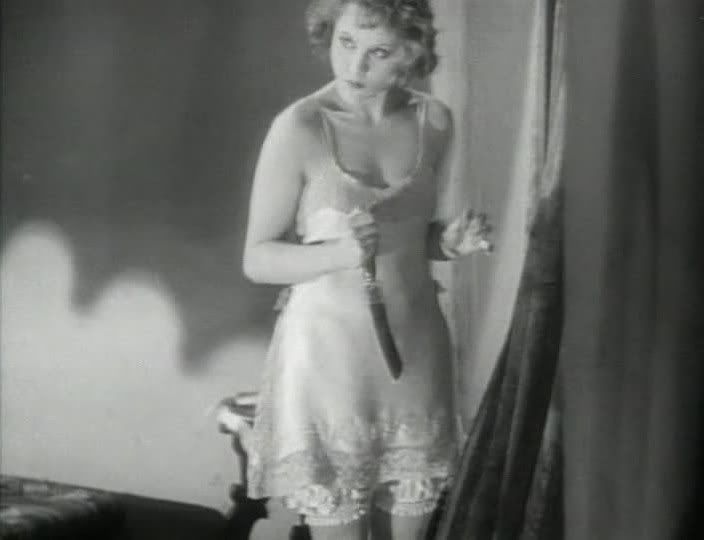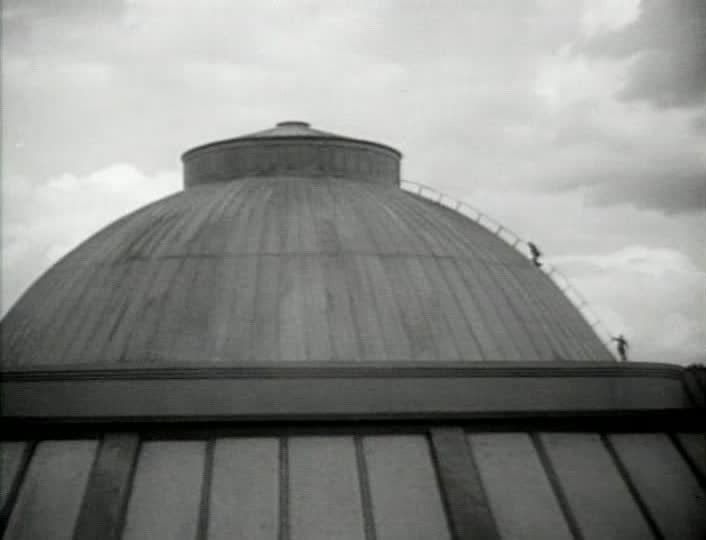 [This post is a contribution to the third annual For the Love of Film blogathon and fundraiser, which will be running from May 13-18. This year, hosts Marilyn Ferdinand, Farran Smith Nehme and Roderick Heath have dedicated the week to Alfred Hitchcock, whose early (non-directorial) work "The White Shadow" will be the beneficiary of any money earned during the event. Be sure to donate!]
[This post is a contribution to the third annual For the Love of Film blogathon and fundraiser, which will be running from May 13-18. This year, hosts Marilyn Ferdinand, Farran Smith Nehme and Roderick Heath have dedicated the week to Alfred Hitchcock, whose early (non-directorial) work "The White Shadow" will be the beneficiary of any money earned during the event. Be sure to donate!]Blackmail was the first British sound film, though it didn't start out that way. Alfred Hitchcock originally shot it as a silent before recutting it for sound, shooting new scenes and dubbing existing ones. The film is as rough as one would expect based on those origins, continually betraying its status as a hybrid in which many of the scenes were simply taken whole from the silent version and dubbed over. Sound enters the film only gradually, so that its first ten minutes provide a microcosm of the evolution from the silent era to the coming era of sound. The opening eight minutes are carried over from the silent version virtually unchanged: a pair of detectives visit a suspect, apprehend him, and interrogate him, and all of it plays out entirely without dialogue, even when they seem to be chatting profusely.
Hitchcock is saying goodbye to the silents that nurtured his talent, and saying it with panache, delivering unforgettable images like the detectives stoically staring at their target, slatted shadows laid across their faces, or the great zoom that shows the target catching a glimpse of the cops in a small shaving mirror. Slowly, bits of synchronized sound begin to appear, like a sound effect of footfalls when the prisoner jumps out of the paddy wagon. Soon, the detectives start to talk a bit, and then, when one of the detectives, Frank (Jack Longden), meets up with his girlfriend Alice White (Anny Ondra), the film bursts fully into sound.
The film's rather basic plot revolves around Alice, who has grown bored of the hard-working, stolid Frank, so she makes a date with another man, an artist (Cyril Ritchard), instead. She goes back to the artist's flat one night, he tries to rape her, and she kills him in self-defense, fleeing the scene. She leaves behind a key piece of evidence, though, and it's recovered by the weaselly criminal Tracy (Donald Calthrop), who attempts to blackmail Alice and Frank as the police investigate the crime. Hitchcock, somewhat hobbled by the static cameras required by early sound film, often turns this limitation into an advantage by composing images that rely on subdivisions of the frame to create visual interest. The attempted rape and murder happen offscreen, signified only by the flapping of the bed curtains at the far right side of the frame, while Hitchcock holds a steady shot that's mostly negative space except for a bedside table stacked with cheese. Alice's hand desperately fumbles at the table, grabs a knife, and after a time, the curtains stop moving, and then the artist's hand flops out, lifeless. Alice then steps out from behind the curtains, shocked and stiff, holding the knife in her fist in front of her, her eyes wide and staring, looking down at the weapon in surprise and then slowly placing it on the table as though it takes great effort to let go of it.
Earlier in the same sequence, before the murder, Alice changes into a dress to model for the artist, and Hitchcock stages the scene with the artist playing piano on the left side of the frame, separated from Alice, who's stripping down to her negligee right behind him, by a dressing shade. The shot is composed so that, while the artist faces off to the left side of the frame, Alice directly faces the camera, displaying for the audience what she's so carefully modest to hide from the artist. It's a clever bit of voyeuristic framing that is playful at first and then becomes creepy after the artist drops his gentle coaxing of Alice and becomes overtly rapacious. Later, Hitchcock is similarly playful with framing and space in the crowded mise en scène of the Whites' general store, where Tracy, Frank and Mr. White (Charles Paton) have to squeeze past each other during the scene where Tracy forces his way into their parlor with subtle threats. The physical closeness creates subtle comedy that's tied up with the understated menace of this creepy blackmailer.

Hitchcock's cinematic imagination displays itself in several other key sequences here, including early signs of his keen grasp of sound. After the murder, Alice begins seeing reminders of her guilt everywhere she goes, like a neon sign that she imagines showing a hand stabbing a knife repeatedly downward. Most notably, she sees certain extended hand postures — a cop signaling traffic, a mannequin's lifeless claw, a bum's slouched posture — as echoes of the dead man's hand falling out of the bed curtains. Hitchcock cuts from a shot of Alice standing over the bum, transfixed by his extended arm, to a similarly composed shot of the landlady discovering the artist's corpse, with its hand stretched out in the same way. A shrill scream accompanies the cut, a jarring, perfectly timed sound that links Alice back to the man she'd killed.
Also striking is the famous chase sequence at the British Museum, in which Tracy, now the prime suspect in the murder that Alice committed, flees from the police through the rigid geometric layouts of the museum: long chains of doors that seem to stretch to infinity, rows of book shelves with corridors tucked away between them, a coiled maze of desks, display cases which the fleeing man ducks around with the cops in pursuit. Hitchcock filmed the sequence with a special process very similar to the matte backdrops that he would often deploy in his later films, using still photographs of the museum, which contributes to the slightly disconnected, artificial feel of the scene. Adding to the suspense, Hitchcock continually cuts back to static shots of Alice, anxiously waiting at home to hear what has happened.
The film isn't always so thrilling, and there are several long, indifferently staged dialogue scenes to suggest that Hitchcock hadn't fully gotten the hang of sound yet, despite the innovations with it that he already displays here. But those periodic dull stretches are redeemed by the master director's inventiveness and his wicked sense of humor, which often enlivens the film at unexpected moments. Probably the best humorous aside is a gossipy woman's tossed-off line about how it's better to murder someone with a brick to the head — "there's something British about that" — than with a knife.
Then, in the final scene, Hitchcock strikes a jaunty, broadly comical tone, as the police, satisfied that the case is closed, shrug off Alice's attempts to confess and turn herself in, laughing at her with the condescending implication that they think she's just a silly woman. She joins them in their cackling laughter, though the comic tone of this finale is slightly undercut by the reappearance of a painting of a jester that had been in the artist's studio. Hitchcock cleverly cuts to the painting while the laughter continues, so that it seems as though the painted figure is himself laughing, and then the painting moves, revealing that it's being carried away, a last piece of evidence being carted off into storage now that the case is over. This ending, rich in irony and tragicomic suggestion as it is, is a perfectly Hitchcockian conclusion, an inversion of his later "wrong man" template: in this one, the wrong man dies for the crime he didn't commit, while the murderess laughs it off with the boyfriend who's helped her cover it all up. What a great happy ending!
This early sound Hitchcock can rightfully now be referred to as a classic, certainly one of his best films from this period. The use of sound is shaky and there are static moments to be sure, but as you rightly note there are also unforgettable images and that delightful dash of comedy that eventually became a Hitchcock trademark.
ReplyDeleteAgain, a master-class piece for this blogothon.
Thanks, Sam. It's definitely peak early Hitchcock. It has a lot of the shaky characteristics of early talkies but is a lot of fun and already feels a lot like later Hitchcock with the "wrong man" themes (although very differently explored here) and the big climactic set piece.
ReplyDelete